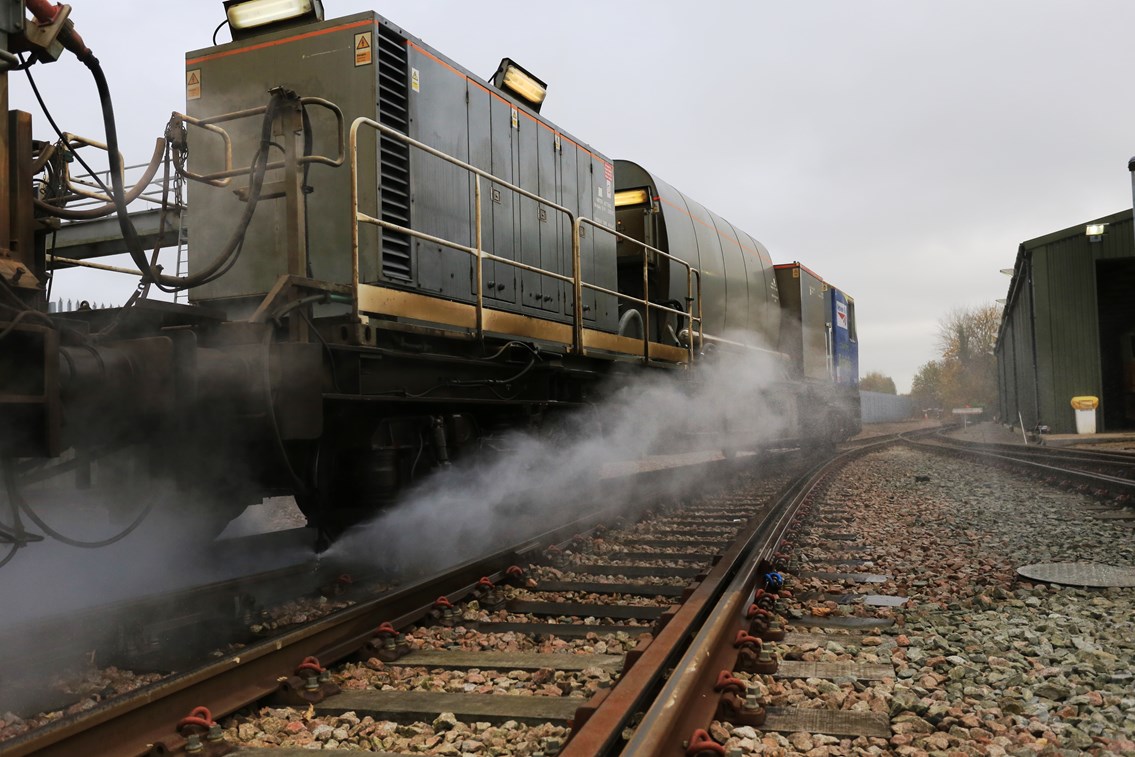Friday 3 Nov 2017
VIDEO - Why “leaves on the line” is no joke for Network Rail and Southeastern
- Region & Route:
- | Southern
Imagine driving a train with more than 1,000 passengers on board, all relying on you to carry them safely home to their families. You need to know that the train will stop where you want it to, when you want it to, whatever the weather.
Network Rail and Southeastern work very hard to ensure trains run safely through the worst of the weather, with safety systems and special timetables helping to keep the railway run reliably.
When a train wheel runs over autumn leaves, it squashes them into a paste. As the following wheels of the train roll over the mess, it quickly bakes hard into a tough black coating – the black ice of the railway. Add rain into the mix, and there is a serious risk that a train will lose grip, either unable to accelerate or worse, unable to stop. And if the leaf-paste goes unchecked, it can insulate the trains from the tracks, making signalling safety systems fail safely.
By working together, Network Rail and Southeastern can make sure that doesn’t happen and that trains can run on time throughout the autumn and winter.
Network Rail runs special engineering trains around the clock to clear leaves from the line while Southeastern trains equipped with sanders lay a coating of dry sand on the rail, giving the train extra grip. Drivers also spend additional time in train simulators, practising driving in challenging autumn and winter conditions.
Network Rail’s chief operating officer Andy Derbyshire said: “Leaves on the line are not a joke, they are a real risk, never mind the delays they cause, and each year our trains run more than 180,000 miles on a 24/7 programme of rail treatment to keep lines clear.
“Our fleet of 19 special engineering trains run across the South East all day every day, blasting the rails clear with water jets – powerful enough to cut through the contamination left by the leaves on the top of the rail - and laying a sandy gel that helps trains grip better.
“But even with those trains running around the clock, on bad days where we have lots of wind and rain, it can be a challenge to operate as punctually as we would like. That’s where we have to work very closely with Southeastern.”
Ellie Burrows, Train Services Director, Southeastern said: “The complexity of our network and the sheer number of trains we run – more than 2,000 each day – means that small delays of a few seconds along the journey can quickly add up becoming big delays at the destinations.
“To ensure safety and provide reliability, we run an amended timetable in the autumn months. This means that some trains take slightly longer to reach their destinations, we operate a special off-peak only timetable in Metro areas when the weather is particularly bad. This is how we make sure that every train and crew is in the right place to run a reliable service. We also make sure our drivers spend additional time on our training simulators to practice accelerating and breaking when rails are slippery.
“We really appreciate our passengers’ patience and understanding, along with Network Rail, our priority is getting everyone to and from work reliably and safely during these months.”
Notes to Editors
- Last year on South East Route Network Rail undertook 182,945 miles of water jetting treatment (Equivalent of going around the Earth seven times!)
- Network Rail laid 40,250 miles of Adhesion Modifier. (20% increase from 2015)
- In 2015/16, Network Rail spent almost £6m on vegetation-related delays in the South East [check if this is Sch 8 or vegetation clearance]
- Network Rail has six rail head treatment trains (RHTTs), with diesel locomotives at each end. These have a long range and are able to run reliably on the most heavily affected routes. Their longest circuits are 16 hours, with a driver swap half way. They are based at Tonbridge West yard and are operated by GBRf. The locomotives are four Class 66s and eight class 73s.
- Seven multi-purpose vehicle (MPV) trains are based at Tonbridge East yard, operated by Balfour Beatty, and six MPVs at Horsham, also run by Balfour Beatty. Their longest runs are 10 hours.
- At the peak of the autumn season, 20 circuits will be run every day, over many hundreds of miles.
Contact information
Passengers / community members
Network Rail national helpline
03457 11 41 41
Latest travel advice
Please visit National Rail Enquiries
Journalists
Network Rail press office - Chris Denham
Operational Communications Manager
020 3357 7969
07515 626530
chris.denham@networkrail.co.uk
About Network Rail
We own, operate and develop Britain's railway infrastructure; that's 20,000 miles of track, 30,000 bridges, tunnels and viaducts and the thousands of signals, level crossings and stations. We run 20 of the UK's largest stations while all the others, over 2,500, are run by the country's train operating companies.
Usually, there are almost five million journeys made in the UK and over 600 freight trains run on the network. People depend on Britain's railway for their daily commute, to visit friends and loved ones and to get them home safe every day. Our role is to deliver a safe and reliable railway, so we carefully manage and deliver thousands of projects every year that form part of the multi-billion pound Railway Upgrade Plan, to grow and expand the nation's railway network to respond to the tremendous growth and demand the railway has experienced - a doubling of passenger journeys over the past 20 years.
Follow us on Twitter: @networkrail
Visit our online newsroom: www.networkrailmediacentre.co.uk

